Declutter
Clothing clutter usually occurs due to improper folding or excess clothing. So take everything out of the wardrobe and put it on the floor or bed. Before putting it back in the closet, get rid of unnecessary outfits. Torn, faded and stretched clothes can be thrown straight into the trash. It will not be possible to return them to their original appearance.
- Clothes that have not been worn for more than a year should not be stored in the wardrobe. They only take up space in the closet. The exception is formal wear: suits and evening dresses. If you feel sorry to throw things away, you can sew an original blanket or chair covers from them.
- Shirts, trousers, T-shirts and blouses that have become tight should not be stored in the hope of losing extra pounds. You should also get rid of wardrobe items that you don’t like in appearance or that don’t suit your style. Low-quality items that highlight figure flaws can be thrown out.
- It’s easier to tidy up a child’s closet. Clothes that the baby has outgrown can be simply put away on the mezzanine. They will probably come in handy in the future. If you wish, you can give the items to relatives or friends with children.
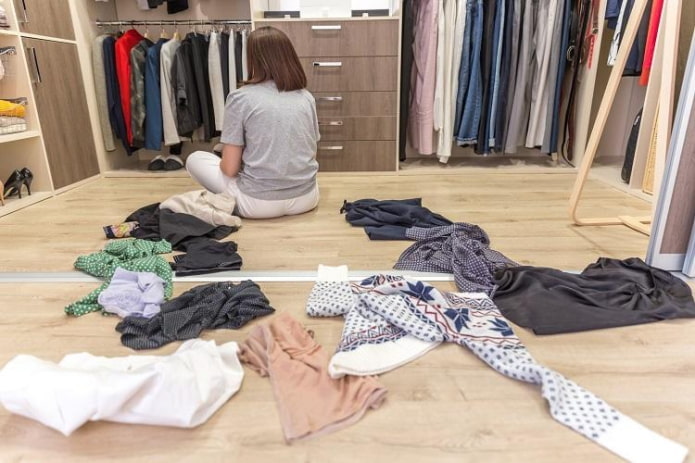
Choose the right contents
The typical wardrobe depth is 55-60 cm. 50 cm is enough to store light items in a wardrobe. In the hallway, it is better to install furniture with a depth of at least 65 cm so that outerwear can easily fit in it: fur coats, down jackets and coats. When the wardrobe dimensions are smaller, it is recommended to turn the items in it by 90° C to avoid wrinkled edges.
The length of a wardrobe section can be any, if it has a standard depth. In the case where this parameter is only 50 cm and there is an end bar, only 7-9 items of clothing will fit. The width of the closet module usually depends on the number of crossbars. Only a few clothes can be placed on the end bar. Therefore, with a module width of about 55 cm, it is recommended to install a longitudinal bar.
The height of the compartment depends on the type of clothing and the way it is stored. For example, the hem of a long sundress hanging on a hanger should not touch the floor and wrinkle.
It is convenient to store short clothes on 2 bars, the distance between which is about 80-100 cm. The optimal height of the module for jeans or trousers is 130 cm. It is advisable to install the bar for dresses or coats at a distance of 170-190 cm from the bottom panel. If you hang it higher, you will have to use a device for removing things in the closet.
Shelves are no less important. Drawers in the middle of the structure are a great option for permanent use. To store large items, winter gear, pillows or blankets, you will need shelves. It is worth allocating a section 80-120 cm wide for them. The length of the shelves should not exceed 80 cm if you plan to store heavy things on them. Make the height between the boards at least 40 cm. It can be doubled for 2-3 sections to store containers with shoes or suitcases.
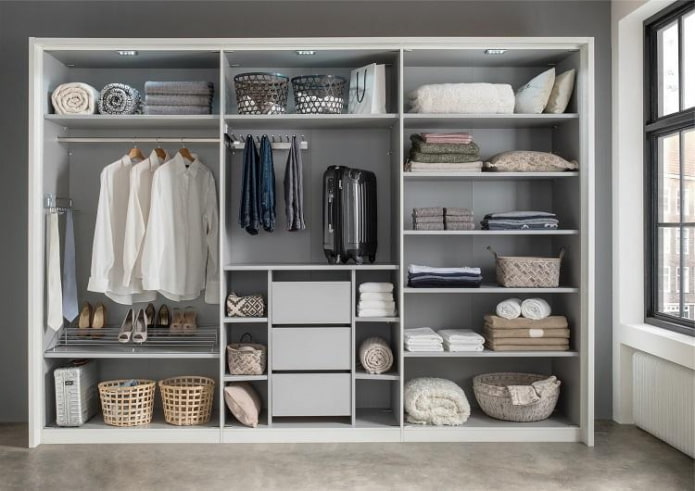
Recommendations for types of things
To avoid disorder in the closet, you need to properly organize the space. There are several tricks on how to do this as efficiently as possible.
Storing shoes in a closet
It is recommended to put sneakers, boots, and shoes in boxes. The following will do:
- homemade ones made of cardboard or left over from purchase;
- fabric cases;
- plastic organizers.
Choose wide items that will not spoil your shoes. If the box is opaque, stick a photo to it and sign it so that you don’t have to spend a long time looking for the right pair. It is worth inserting shoe trees into your shoes, otherwise they may become deformed during long-term storage. It is better to place organizers with shoes in a separate section or on the lower shelves of the wardrobe.
It is reasonable to keep house slippers, sandals, ballet flats, and sliders in a case with pockets. It can be hung outside or inside the wardrobe.
Important. Do not store shoes at temperatures below 14° C and high humidity. Therefore, it is not recommended to install the cabinet in an unheated room.
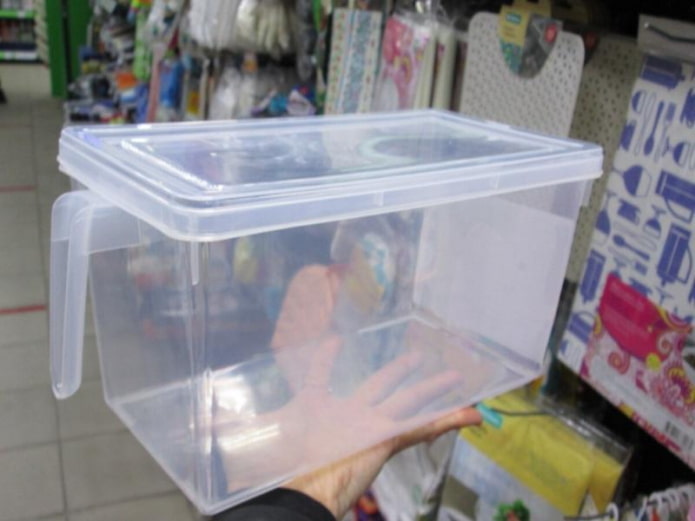
Everyday clothes
Put such things on shelves, especially knitted and jersey ones: sweaters, turtlenecks, cardigans. Store T-shirts and tank tops in neat stacks. Everyday clothes should be at eye level. Hang jeans in the closet. If there is not enough space, put them on the shelves. Although this product is made of dense material, it should not be stored crumpled.
Fold jeans using the classic method: first connect the legs, fold the seam to get a rectangle, twist the length. Send shirts, trousers, blouses, dresses, jackets, skirts to hangers.
Bags, belts, clutches, scarves
Glue hooks to store bags in the closet. If you don’t want to spend time on this, then place them on the shelves using dividers. Before putting the bag in the closet, stuff it with lightweight material. This trick will prevent creases and keep its shape.
Store accessories that you wear all the time close by – on the closet door or in drawers. Again, hooks will come in handy for ties, you can use hangers with clip-on clothespins. Place belts and sashes on a paper towel stand, having previously rolled them up. Keep purses and clutches in plastic paper trays. Accessories arranged this way are always in sight, their shape and appearance do not change.
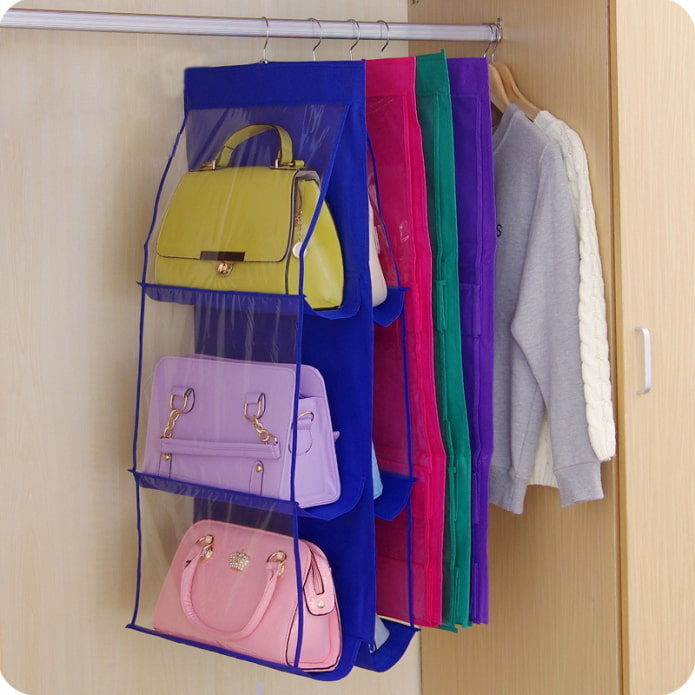
For scarves, it is reasonable to purchase split rings made of metal or plastic so that many beautiful accessories fit on one hanger.
Seasonal clothing
Things are divided into everyday and seasonal. The former are worn every day, and the latter have to be put away periodically. Before putting summer clothes into storage, they need to be sorted and sorted. Sundresses, trousers and suits made of wrinkle-resistant materials should be kept in a cover on a hanger until the next season. Other textiles are folded into piles, then put away in plastic or fabric bags. It is good to keep swimsuits and swimming trunks in a separate box.
Clean summer hats before putting them in the closet, wrap them in cloth. Put hats in boxes pre-treated with pest control products. Rinse sandals and shoes thoroughly with water, let them dry and apply protective agents.
Each pair requires its own box. Before storing, remove the insoles from the shoes and put them next to each other. Insert shoe trees or paper into the shoes so that they do not lose their shape. Also throw silica gel into the packaging to absorb moisture.
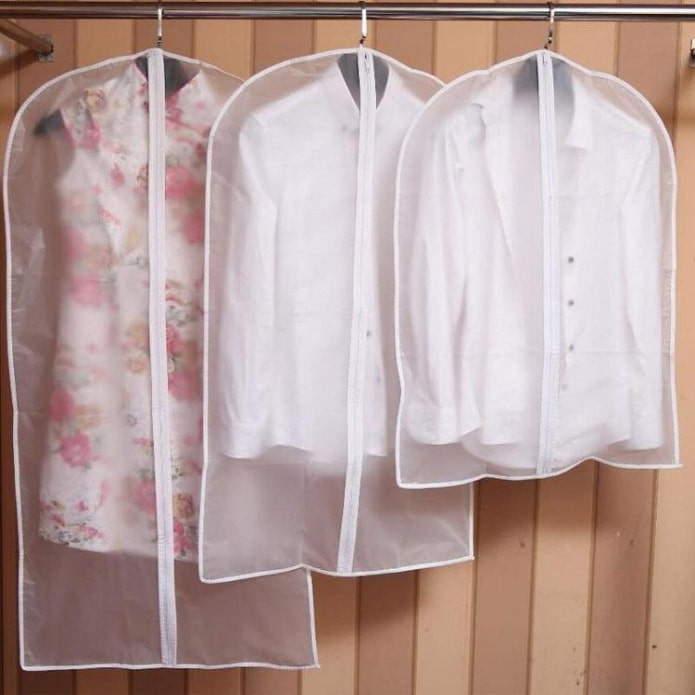
How to fold things correctly?
If you want to achieve perfect order in your closet, you need to follow some rules:
- Fold underwear and socks in hanging organizers with compartments or trunks. It is easier to find the right thing in them, since nothing will get mixed up. You can put small items in a chest of drawers.
- Keep trousers and sweaters worn every day on shelves that are at eye level. Fold unclaimed items on the lower tiers.
- Sort things by material and color so you don’t have to spend a long time looking for them on the shelves.
- Send seasonal items to the upper tiers or mezzanines. Hang suits and coats on hangers. For outerwear, use strong wooden hangers designed for heavy weights.
- Socks, stockings, T-shirts, and tank tops can be folded vertically in drawers.
When the closet is spacious, it is better to organize storage of items on hangers.
Note. Do not put wet clothes together with dry ones. The steam effect in a warm wardrobe will lead to the appearance of mold and mildew on damp fabric. In addition, the items will emit a musty smell.
How to save useful space?
To avoid filling the entire closet with things, it is worth using drawers or baskets, shoe shelves, convenient organizers for underwear, slippers or jewelry.
Wire baskets can hold many different items: scarves, gloves, hats. This is an ideal transparent storage system that allows you to save a lot of space. Such structures are fixed to the door or to the wall of the closet. You can hang an organizer with pockets on the side of the wardrobe. Put socks or underwear in it.
Fold small towels in half and then roll them into a tube. In this form, they can be laid both vertically and horizontally, which significantly saves space for storing other things.
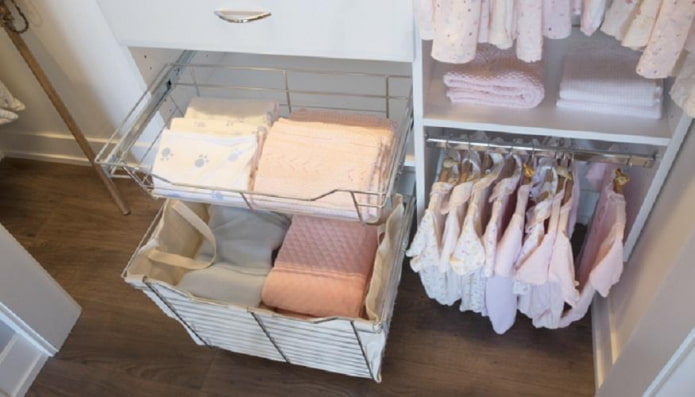
The second rod will be needed when there is too much clothing. Use the lower crossbar for skirts, trousers or jeans, and the upper one for jackets, blouses and suits. Multi-tier hangers will help save space. They will be able to accommodate more clothes than on simple hangers.
If there is not enough space in the closet, then seasonal wardrobe items should be put away in vacuum bags. Folded clothes are placed in a bag and the air is sucked out with a vacuum cleaner hose. Thanks to these packages, there will be free space in the wardrobe.
Clothes, correctly folded and hung in the closet, are not only beautiful, but also profitable. You will not have to iron and wash them every time. Things in the wardrobe, if properly organized, retain their original appearance for a long time.
Now reading:
- Modern interior of a studio apartment 43 sq. m. by Geometrium
- Kitchen-living room design 17 m²: 44 real photos and design ideas
- Space zoning: 60 photos, ideas and methods for room design.
- Wooden kitchen: design, decoration, photos and ideas for a kitchen-living room
- 10 ideas for window decoration in the country to create coziness in the interior.